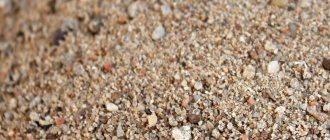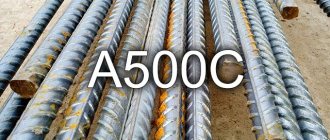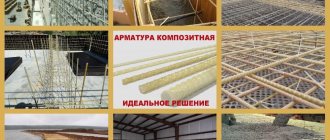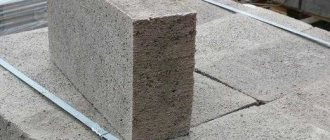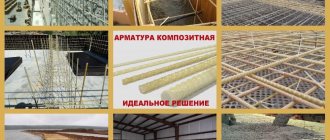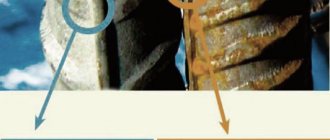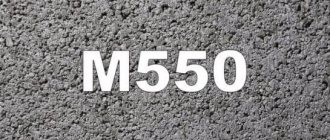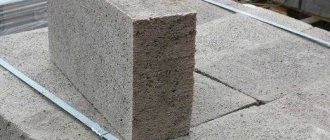Reinforcement is a metal product in the form of a rod. Reinforcing bars are considered important elements of construction. They are obtained by rolling steel at metallurgical plants, subjecting them to high temperatures. Waste is removed from the steel and impurities are added, reducing carbon levels and increasing the strength of the rods. After manufacturing, the fittings are subjected to inspections and compliance with GOST. The production and sale of fittings are areas of high demand, as they are used in civil and industrial construction. This article will help you consider in more detail what reinforcement is.
Necessity of application
Reinforcement is needed for the strength and durability of concrete and is used in any construction process. The resistance of concrete to tension is much less than to the compression factor. Thanks to the corrugated surface, the reinforcement is well fixed in concrete and reduces its deformation.
Reinforcement is a metal product in the form of a rod.
Pure concrete does not have high strength properties, and to increase its durability, concrete and reinforcement are combined in reinforced concrete. Reinforced concrete structures are designed to reliably strengthen the building in comparison with conventional concrete:
- reinforcement protects concrete from sudden temperature changes;
- strength increases with simultaneous exposure to compression and tension factors;
- reinforcement prevents the formation of concrete cracks.
Reinforcement is also used in the foundation. It takes on all types of loads from higher structures and therefore must be as durable as possible. Additionally, the foundation is affected by ground movements and frost heaving. The reinforcement in the foundation acts as an effective protection and helps resist concrete deterioration.
Reinforced concrete rules
The strength of the entire reinforced concrete structure is determined by the correct connection of the two materials. The most important thing is how the concrete transfers the stress resulting from the load to the steel reinforcement. If no energy is lost in the process, the strength will be maximum.
Here it is necessary that there is no shift in the connection - an indicator of 0.12 millimeters is allowed. The connection between reinforcement and concrete must be strong, precise and completely immovable. It is important to correctly perform theoretical calculations and correctly implement them in practice, observing all the rules for the production of reinforced concrete structures.
General classification of fittings: types
Depending on the type of material made, reinforcing bars are:
- Metal. Traditional fittings are made from metals; they have high heat resistance. During the reinforcement process, it can be bent and welded.
- Composite. They are made of glass, basalt and carbon fibers. The most popular fiberglass reinforcement is that it does not conduct electricity and is not subject to corrosion.
Metal fittings
Depending on the manufacturing method, the fittings can be:
- Rod . Such fittings are used most often. The diameter of the rods is from 6 to 80 mm, they are manufactured by cold and hot rolling, serve as a frame for reinforced concrete structures and can be:
- Smooth. No protruding bends on the surface.
- Periodic profile. They consist of periodic small projections along the entire perimeter.
- Wire . The size of this reinforcement reaches 10 mm. It is made by cold drawing rods through a series of holes of decreasing diameter. As a result, the wire reinforcement rods narrow in diameter and increase in length.
- Ropeway . The fittings are made of wire. The diameter of high-strength rope rods is from 6-15 mm. There should be no broken wires or dents.
Depending on the installation, the fittings are divided into three types:
- Piece . Used in formwork for private construction of small-scale work. Individual elements are used in frames and reinforcement meshes.
- Reinforcement mesh . Ready-made interlacing of vertical and horizontal rods for the foundation and floor slabs.
- Frame . Frame structures are designed to reinforce columns and beams.
The choice of a specific type of reinforcement depends on the location and method of its application.
Reinforcing mesh 50x50x3 mm in cards
What problems does reinforcement solve?
For a more reliable connection of concrete with reinforcement, it is made with a relief surface. The surface can be crescent-shaped, ring-shaped, four-sided or mixed. The last two types show the best grip results.
To ensure the strength of a structure being built with your own hands, you need to strictly adhere to the consumption rates of aggregates and steel. So, in each individual case, the consumption of materials will be different. For a foundation, on average, this norm is 150-200 kg per 1 cubic meter. For load-bearing floors - it increases to 200 kg.
Previously, only metal (steel rods) were used for this procedure. Nowadays, reinforcing materials for concrete are represented by super-strong glass, basalt and carbon compounds. Concrete reinforced with fiberglass is widely used, which demonstrates better wear resistance and makes the material lighter. It has a number of advantages, which the table clearly shows.
Varieties
According to their purpose, fittings can be of the following types:
- Working . The most significant type of reinforcement, which has high strength, bears the main loads of the structure. In turn, it stands out:
- Transverse working reinforcement is often produced in the form of clamps. Retains the load from the transverse force of the structure and is installed perpendicular to the longitudinal reinforcing bars.
- Longitudinal reinforcement takes the load from compression and tension factors along the vertical axis of stressed structures.
- Distributive (structural) - distributes the load of working reinforcement over the entire area and ensures its integrity. Placed in areas of stress concentration and sudden changes in the cross-section of the structure.
- Assembly room . It is used to strengthen the frame and connects all parts. In some cases, structural and working reinforcement can simultaneously perform the functions of installation reinforcement.
Each of these types of reinforcement provides maximum strength and durability in a specific location of the building structure.
Advantages and disadvantages
If you ask yourself why reinforcement is needed in concrete, why use two materials in a structure at once instead of choosing one, it becomes obvious that steel and concrete solution exhibit all their best properties exclusively in tandem.
The main advantages of reinforced concrete construction:
- Rigidity, the ability to withstand bending, stretching, impacts, shrinkage, take any shape without loss of strength, taking any type of impact
- Long service life
- Resistance to temperature influences, moisture
Disadvantages include an increase in the weight of the structure (which must be taken into account in the project and all indicators must be calculated), difficulties in rebuilding, and changing ready-made systems.
Application area
Reinforcement is very widely used in construction:
- civil buildings;
- bridges, hydroelectric power plants and dams;
Rebar in construction
- plants and factories;
- used in laying foundations;
- mines, airfields and port facilities.
Reinforcement is used in the manufacture of crowbars and pins; in addition, rods are popular in private use in summer cottages (in outbuildings, fences and sheds).
Search devices
The principle of operation of such devices is to register changes in the electromagnetic field when colliding with metal objects.
PROFOSCOPE
The lightness and convenience of the device allows you to work with one hand, which makes it possible to mark reinforced rods in parallel.
- the determined diameter of reinforced rods is 0.5–5.7 cm;
- measured concrete layer 0.5-18 cm;
- operating temperature -100C - 600C.
Return to contents
NOVOTEST Armaturoscope
These devices have three operating modes:
- the main one is to determine the concrete layer with a known diameter of reinforced rods and vice versa;
- scanning;
- deep search.
NOVOTEST Armaturoscope determines the diameter of reinforcing bars using a dielectric spacer. The device consists of a block and a sensor, which is attached using cables. Operation is provided by conventional rechargeable batteries.
Specifics of marking
Reinforcement marking is a special designation that helps to better understand the diameter of the reinforcement, its appearance and characteristics. Created to simplify the choice and quickly navigate various types of reinforcing bars. Rod reinforcement is divided into 6 classes:
- Class A240 (A1). Reinforcing bars of class A240 are smooth and without indentations, which is why they have worse adhesion properties to concrete compared to profile reinforcement. It is used as an addition to the main fittings and is available in different diameters and lengths. Used in the formation of frames. If the building is small, it can be used independently (in the strip foundation of a summer house or swimming pool). It has low cost and increased elasticity.
- Class A300 (A2). Periodic profile reinforcement with various diameters from 10 to 80 mm is very popular and is needed in the manufacture of reinforced concrete slabs and the construction of private houses. Denser than class A1 reinforcement.
Specifics of marking fittings
- Class A400 (A3). The rods of this class are equipped with a ribbed surface. Their diameter ranges from 6 to 40 mm. The reinforcement is very popular due to its low cost and high strength. It is used in welding and reinforced concrete structures, in the construction of road slabs and coatings, as well as in the reinforcement of concrete walls of buildings.
- Class A600 (A4). Used in stressed and non-stressed reinforced concrete structures. A600 class reinforcement with a diameter of 10 to 32 mm is used in reinforcing building foundations and in the production of reinforced concrete structures; they are often tied into frames.
- Class A800 (A5) and A1000 (A6). Rods with grooved ribs with a diameter of 6-36 mm are made from low-alloy steel. Reinforcement class A5 and A6 of high strength and cost. They are used only in the industrial construction of large factories, factories and structures.
There are also more detailed characteristics in markings with different designations:
- The letter “K” indicates additional treatment of reinforcing steel with anti-corrosion substances (At800K).
- The letter “C” makes it possible to understand that the rods are well welded (At400C).
- The letter “t” added to the index means thermally strengthened reinforcement (At800K).
- The letter “c” is reinforcement reinforced by exhaust hood.
A little math
Before you begin strengthening the strip foundation, it is necessary to calculate the reinforcement. This will allow you to stock up on the right amount of material in advance and select the right parameters.
First, they consider the diagram of the future house in order to determine the number of strips for the foundation. A standard building has four external walls and several internal ones (in our case, let there be two load-bearing ones), which means there are six foundation strips in total.
Mathematical calculations can be considered on a specific option.
For example, a square-type house is being built with a wall length of 10 m. The number of rods in each of the main belts is taken to be 2. In this case, the calculation of the reinforcement will look like this:
- The length of the house is multiplied by the number of strips and the number of rods in two belts: 10 x 6 x 4 = 240 m - the total length of the main reinforcement with rods d = 12 mm.
- The length of the internal walls is added to the perimeter of the house (let’s say each is 10 m): 40 + 2 x 10 = 60 m - the total length of the tape.
- The previous parameter is multiplied by 5.4 - the average coefficient for each meter of tape: 60 x 5.4 = 324 m - the total length of auxiliary reinforcement
The calculation was made for a tape 80 cm high and 40 cm wide. The mathematical operations are quite simple, so calculating the required number of rods is not difficult.
If we are talking about the foundation, then this is reinforcement with a diameter of at least 12 mm, welded or connected in a cell format with dimensions of 50x50 millimeters. The walls of a building made of concrete can be reinforced in the longitudinal direction in increments of 0.4-0.5 meters. At the same time, the adhesion of the reinforcement to concrete is ensured by its design features - longitudinal and transverse corrugation.
Scheme of strip foundation reinforcement. Longitudinal joining of working reinforcement. Reinforcement of corners.
Let's consider the reinforcement scheme for a strip foundation using the example of a one-story house with an attic measuring 10x6m in plan.
An example of strip foundation reinforcement.
Longitudinal reinforcement is made with six reinforcement bars of class A-III with a diameter of 12 mm. Transverse - with clamps made of class AI reinforcement with a diameter of 8 mm. The spacing of the clamps is 200mm in the area of corners and T-shaped intersections, and 600mm in other places.
The corners and places of T-shaped intersections are reinforced with corner and diagonal haunches made from class A-III reinforcing bars with a diameter of 12 mm. The overlap of the haunches in the area adjacent to the longitudinal rods is assumed to be 50 diameters (50x12mm=600mm).
In this case, joining along the length of the working reinforcement rods can be done with an overlap along the length of an identical length (600 mm). In such places it is also advisable to install clamps with a rapid pitch (200mm). The length of the reinforcing bars reaches 11.7 m. If possible, in order to reduce the amount of work, longitudinal connections should be avoided.
Reinforcement of corners and T-shaped intersections can also be done with so-called tabs. They represent an L-shaped bend of the longitudinal rods by the same amount of 50d.
An example of reinforcing the corner of a strip foundation with claws.
When reinforcing strip foundations, the requirements for a protective layer of reinforcement must be met to avoid rusting. For foundations, the protective layer is 40 mm at the side and top edges. For the sole, it is also allowed to take 40mm in the case of a preparation device made of concrete class. B2.5...B10 100mm thick. Otherwise, the protective layer for the sole will have to be increased to 70mm.
Structural requirements for strip foundations and their reinforcement
Due to some unpredictability of the degree of uneven settlement, an accurate calculation of the required diameter for a strip foundation is hardly possible. Therefore, over decades of construction and operation of buildings, design requirements for the reinforcement of strip foundations have been developed.
- The diameter of the working rods is taken to be at least 12mm.
- Working (longitudinal) rods are combined into spatial frames using transverse reinforcement by welding or knitting.
- The number of longitudinal rods in the frame is at least four (usually six).
- The transverse reinforcement pitch is assigned in the range of 200-600mm. The diameter of the rods is 6-8mm.
- The thickness of the strip foundation is usually taken to be 300mm.
- Weak spots in corners and T-shaped intersections are reinforced with reinforcing haunches or tabs. Their diameter is assumed to be equal to the diameter of the longitudinal rods.

